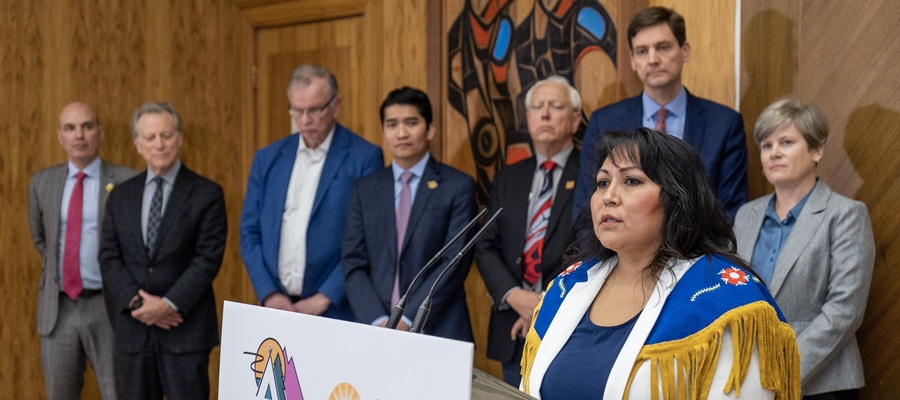Debunking the Fraser Institute’s latest scaremongering on Indigenous rights
In a particularly dick move (sorry, no other term for it), the Fraser Institute chose National Aboriginal Day (June 21) to release a report by Tom Flanagan claiming that a sharp increase in people with Registered Indian status will drive up government costs.
The methodology employed by Flanagan is remarkably shoddy, as I explain below. I’m not sure what sort of peer review process the Fraser Institute follows, but they should be embarrassed.
The report1 and its associated news release make three dubious and related arguments:
1. The news release leads with the alarmist and misleading claim that, between 1986 and 2011, “Canada’s indigenous population increased by a staggering 275 per cent.”
However, this merely captures how many people self-identify as having Indigenous ancestry to Statistics Canada on the Census form. It has no connection to official status under the Indian Act or associated so-called “entitlement” to public “benefits.”
The report itself acknowledges this important distinction, noting that “by far the greatest growth occurred in the categories of Métis and non-status Indian”—meaning, those who identify as Indigenous but have no official status under law as Indian or Inuit.
Focusing on the Census numbers is, at best, wilfully alarmist.
Census numbers merely capture how many people self-identify as having Indigenous ancestry; they have no connection to official status. Focusing on these numbers is, at best, wilfully alarmist.
2. Flanagan nevertheless sounds the alarm over the increasing number of people who actually do have formal “Registered Indian” status, which he attributes in part on a series of legal decisions in recent decades.
The report makes an observation that is true at some level, but puts an odd spin on it. It notes that legal changes to the rules governing entitlement to status have resulted in a boost to the number of “status Indians” beyond what natural population growth alone would have produced:
“Ethnic mobility resulting in the growth in the numbers of Registered Indians has been fostered by adoption of equality rights in the Canadian Charter of Rights and Freedoms (1982); court decisions such as Lovelace (1981), McIvor (2009), and Gehl (2017); statutes such as Bill C-31 (1985) and Bill C-3 (2011); and the recognition by order-in-council of landless bands such as the Qalipu Mi’kmak First Nation (2011). The Registered Indian population is now at least 40% larger because of these legal changes than it otherwise would have been.”
I can’t speak to the validity of that 40% increase claim specifically. But these legal wins surely have boosted the numbers of those with formal status. That was the whole point.
These legal victories attempted to remedy long-standing legislated sex discrimination that unfairly deprived and stripped people of their status—notably Indigenous women who married non-Indigenous men, and their descendants. The laws were changed because courts and international human rights bodies found them to be discriminatory and illegal. (In fact, the legislative system is still flawed by sex discrimination, because successive federal governments have only ever undertaken piecemeal reforms. Further reform is needed to fully eliminate sex discrimination, once and for all.)
Yet Flanagan’s report insultingly refers to some of this regained status as “changes to ethnic labelling.” These legal victories haven’t manufactured indigeneity; rather they improve the constitutionality of the Canadian state’s recognition of it.
The laws were changed because courts and international human rights bodies found them to be discriminatory and illegal. Yet Flanagan’s report insultingly refers to some of this regained status as “changes to ethnic labelling.”
3. Perhaps most obnoxiously of all, Flanagan goes on to claim that the other reason the “status Indian” population has increased is because the benefits of registered status are so juicy, people are “incentivized” to seek it—and that this will put “mounting financial pressure” on governments.
It is this subsequent argument made by Flanagan where the report goes methodologically off the rails.
Specifically, the report argues:
“An important factor in the growth of the status Indian population is the set of positive economic incentives conferred by Registration, including free supplementary health insurance for all Registered Indians and Inuit, and in some circumstances financial assistance for higher education, exemption from taxation on reserve, and special wildlife harvesting rights [which are encouraging people to seek official status and that will mean escalating public costs].” (emphasis added)
These claims are not defensible.
Now, full disclosure: I was an expert witness in the McIvor case cited above. In that case, Sharon McIvor launched a Charter challenge to the Indian Act’s sex discrimination, which affected her, her children, and her grandchildren, whose claim to status was through the maternal line (and thus had been denied). During the case, the federal government lawyers commissioned a report from a Manitoba economist named Stewart Clatworthy purporting to show—based on many of the same methodological flaws that Flanagan repeats—that the costs of a McIvor win to the public could approach a billion dollars.
Based on that report, the feds tried to convince the court to reject McIvor’s equality claim on economic grounds. I was asked by McIvor’s legal team to write a critique of Clatworthy’s economic report, which I found to be riddled with flawed assumptions, and I was subsequently cross-examined over two days.
To cut to that story’s end: McIvor won her case, and in a single paragraph of an otherwise lengthy decision, BC Supreme Court Justice Carol Ross agreed with my critique and dismissed the economic argument.
The core elements of my critique then are essentially the same as apply to Flanagan’s flawed report now (indeed Flanagan cites Clathworthy among his sources):
- Just because someone chooses to tick a box self-identifying as having Indigenous ancestry on a Census form, doesn’t mean they will seek Registered Indian status, or if they do, that they will be successful. In contrast, those who have in fact newly gained status in recent decades are those who should have legally had it all along.
- It is a gross error to assume that all who do newly gain status will claim health, education and taxation benefits or wildlife harvesting rights at anything close to the same level as those who already had status. That is because a large share of those who previously had status lived on reserves, whereas almost all of those who newly gain status do not. Indeed, Flanagan’s own chart (on page 10 of his report) shows the main jumps in status numbers have been off-reserve.
Let’s break that second point down further.
Take the example of health benefits. The second-most expensive component of the “non-insured health costs” currently covered for “registered Indians” (after pharmaceutical coverage) is for health-related transportation—primarily, the cost of getting hospital care off reserve. But most of those who newly gain status don’t live on reserve—they live in cities like most of us, and already have access to that hospital care. They don’t need extra travel costs covered.
Moreover, those who have more recently gained status may have existing access/coverage under private/workplace health and dental plans (either through a parent, partner or their own workplace), and these plans may offer superior benefits to those provided by the federal government for registered Indians. Thus, to assume as Flanagan implies that the take-up/utilization of these services for newly registered Indians will be equivalent to previous per capita costs is false.
It is worth noting that Flanagan’s report is not a full cost-benefit analysis. It considers costs, but neither economic benefits (in the form of either savings or increased returns to government in the future) nor social benefits.
Flanagan’s report highlights that “the medical insurance plan [to which registered Indians are entitled] alone is worth about $1,200 per person per year,” yet this figure surely greatly overstates what that per person cost will be for those who have newly gained status.
With respect to higher education benefits—meaning government assistance for post-secondary fees: Indigenous people do not have this benefit as an “entitlement.” Rather, individual First Nations each have an envelope of funding for such financial assistance, and those with status must apply to their bands for that aid. And the federal government itself has an overall defined funding envelope for such support. There is no guarantee that the envelope will grow commensurate with an increase in the number of individuals with status. And if it does, it just enlarges what one level of government (the feds) transfer to another (the provinces who run post-secondary institutions).
Additionally, some of the specific costs about which Flanagan sounds an alarm could become moot in the future, if governments choose to make some of these services universally covered (i.e. government funding may be extended to all). For example, governments are currently discussing public pharmacare plans, which would reduce the costs associated with the Indigenous-specific drug plan. Various provinces have been extending dental services to all children. Some governments have considered extending vision and dental benefits to more low-income people. And it is not impossible that we will see governments moving to reduce or even eliminate post-secondary fees in the future.
Flanagan makes the same false assumptions with respect to taxation. People with Registered Indian status are only exempt from taxes on income or purchases made on reserve. If most of those who newly gain status are off-reserve, it’s an irrelevant argument.
And as for wildlife harvesting rights, well…
It is worth noting that Flanagan’s report (much like Clatworthy’s analysis) is not a full cost-benefit analysis. Meaning, his report considers costs, but not economic benefits (in the form of either savings or increased returns to government in the future), let alone social benefits. A full cost-benefit analysis is beyond the scope of this critique, but would, among other things, consider the following:
- Post-secondary attendance has a long-run return, not only to the individual, but also to the public treasury, as we note in our report here. Because people with higher levels of formal education tend to earn more income, after graduation they tend to pay more in taxes, and over time this marginal increase in taxes more than offsets the initial public subsidy of their education. Thus, if an expanded provision of post-secondary support results from the proposed amendments, and if this expansion leads to more people attending post-secondary education than would otherwise have been the case, then the “cost” of the program will likely be much reduced or eliminated over time.
- Similarly, studies of prescription drug coverage have pointed to the fact that the failure to provide coverage can result in a “false economy,” and conversely that enhanced coverage can lead to reduced costs, as giving people the financial ability to access needed pharmaceuticals can prevent more expensive acute-care health events. Overall, if the expanded provision of non-insured health benefits resulting from the proposed amendments improves health conditions and outcomes, it is likely a very good investment.
- If some of the newly registered people are on social assistance or have low incomes (and statistically this is a reasonable assumption, as Indigenous people are over-represented among the poor, the unemployed, and those reliant on social assistance for a host of reasons), they would have had existing (albeit more limited) health, pharmacare, vision and dental coverage provided under provincial welfare, premium assistance, and pharmacare plans. Thus, while the proposed amendments may increase somewhat costs borne by the federal treasury, they will likely reduce costs borne by provincial treasuries. Similarly, the amendments may free up post-secondary grant and scholarship money provided by post-secondary institutions or provincial governments, making this money available to others.
- Finally, while difficult to quantify, there are potential social and economic benefits to providing health and education supports to a disadvantaged group within society, and likely broader community benefits would flow consequently.
The Canadian public does not extend these ‘benefits’ to Indigenous people solely because of their ancestry, and it is not done as a goodwill gesture. These benefits are granted because of treaty and other legal obligations.
A final note: underlying the Flanagan report and the alarmism it seeks to convey is what the Fraser Institute puts as a “fundamental question: is it justifiable to offer special government benefits solely on the basis of ancestry?” But the Canadian public does not extend these “benefits” to Indigenous people solely because of their ancestry, and it is not done as a goodwill gesture. These benefits are granted because of treaty and other legal obligations. They are the small price Canada agreed to pay for all that stolen land. To renege on them now would be to dishonour us all.
Notes
- The full Fraser Institute report, entitled Incentives, Identity, and the Growth of Canada’s Indigenous Population, is available here.
Topics: Features, First Nations & Indigenous, Law & legal issues






